An easy-to-follow guide on how to make homemade yogurt using what you already have in the house - no fancy equipment needed! Now you can have freshly made yogurt for a fraction of the cost. This foolproof yogurt recipe will be a new staple in your home.
I am the kind of person who will come up with some random thing they decide they absolutely must do and latch on until it's done. I am talking all-out obsessing over it and finding out everything I can and what materials I need to do it and how much it'll cost and on and on and on. Well, this past few weeks it's been learning how to make yogurt at home. My daughter and I love yogurt and go through a quart of yogurt in a few days. At just under $5 a quart, it can get pretty expensive. I have this book that I love getting inspiration from called Homemade Pantry that had a section on making yogurt at home..... but she uses a yogurt maker which just feels like cheating to me.
While I looked up prices of yogurt makers, I knew I wanted the challenge of doing it "the old fashioned way." Making something like yogurt at home makes me feel as though using a machine to make it takes the fun out of it. Besides, I want to show you that you don't have to spend any additional money on a yogurt maker if you don't want to.
When I first attempted to make homemade yogurt, I didn't use a thermometer because I wanted to see if I could use visual cues (because again, I wanted to see if I could make it this way if you don't have a thermometer available). I got distracted with switching shows on Netflix (anyone else like to watch stuff on their phones or tablets while they cook? My latest Netflix obsession is Lost Girl which is kind of weird, but I can't stop watching it!) and let the milk boil over which is something you do not want to have happen. At this point, the yogurt I used as my starter (more on that later) was not added, so the milk was still usable. I just had to transfer pots because there was now bit of burnt milk on the bottom of my pot and swimming around. Ew. The end results smelled like yogurt, and certainly tasted like yogurt. Sweet! It kind of reminded me of smetana in a way - I really liked it and so did my daughter!
But what you want to look for when you are not being distracted by Netflix, is steam and a lot rumble, especially at the edges. It may even look a bit foamy at the top and/or sides.
The second time I made it, I used a thermometer and made sure I did not let the milk burn at the bottom of the pot. It was perfect! I still believe you don't need a thermometer to make homemade yogurt as long as you aren't me and won't get too distracted.
Basic Tools to Make Homemade Yogurt:
To make homemade yogurt, you will need a starter. You can buy powdered yogurt starter, but store-bought yogurt works too, and is what I use in this recipe. If you use store-bought yogurt, you have to use plain yogurt - the more culture varieties, the better it is for you. If you want flavored yogurt, you can add your flavorings after the yogurt is finished. You also need to use a heavy lidded pot that can retain heat well and a way to keep the pot warm. You can either keep the pot in the oven with the light turned on, or wrapped in a towel. My oven light gets the over really warm, so I wrap my pot in a towel and leave the oven light on for only an hour or so before turning it off.
Can You Make Yogurt With Heavy Cream, Almond Milk, or Coconut Milk?
Yes, you can make yogurt with heavy cream. The yogurt will be thick, and also higher in fat. I recommend using this this yogurt for desserts or for indulgent flavor varieties.
You can make yogurt with almond milk, coconut milk, and other milk alternatives, but it is a bit more complicated. You cannot use commercial almond milk due to the preservatives and thickeners. Unlike traditional dairy yogurt, you cannot use store-bought milk alternative yogurts to make more yogurt. You need to buy yogurt starter and make a fresh batch of yogurt every time instead of using the previous batch to make more yogurt. This type of yogurt also needs to be thickened - gelatin and pectin are popular choices. For these reasons, it can be more costly to make milk alternative yogurt at home.
How to Make Yogurt in a Crockpot
If you want to make yogurt in a crockpot, all you need is a bit of extra time. It is a slower process, but perfect for someone who wants to make double or triple the yogurt. First, you must heat the milk on low in the crockpot. This will take roughly 2 -3 hours. Then you turn off the heat and allow the milk to come down to the temperature of bath water. Mix some of the milk with the yogurt and then mix the yogurt mixture into the milk in the crockpot. Keep the crockpot off, but in a warm area overnight.
How to Make Yogurt in an Instant Pot
Luckily, there should already be a yogurt option on your instant pot which makes it easy to use, but the exact process may still be confusing. First, you need to add the milk to the instant pot and set the yogurt setting to boil (the valve should be set to sealing). Once it is finished, allow the yogurt to cool down to bath water temperature. Use some of the milk to stir into your yogurt, then add the yogurt to the milk. Now you want to set the instant pot to the normal yogurt setting (the valve should be set to sealing or venting). Your timer can be set for 8 - 12 hours, depending on how tart and thick you like your yogurt.
Additional Notes:
- The flavor of your homemade yogurt will be influenced by the type of store bought yogurt you purchase and the cultures they use. I usually use Oikos Greek Yogurt or Fage.
- If you use the oven light method, it will create a warmer environment which I've found also makes the yogurt thicker and therefore produce more whey.
- The fat content will change the thickness and flavor of the yogurt.
- The longer you let the yogurt set and the thicker it is, the more tart the yogurt will be. (I prefer a very thick, tart yogurt)
- There will probably be some whey sitting on top of your yogurt. If that happens, you can either mix it back in for a thinner yogurt, or strain it out with cheesecloth for thicker yogurt. If you strain it out, don't throw it away! You can use it in your baking in place or water, milk, or buttermilk. I love it in my pancakes and muffins!
- When you make yogurt again, reserve ½ cup of your homemade yogurt to make a new batch. You can keep doing this until the yogurt gets a funny taste or smell which is a sign that the bacteria is weakened. When that happens, start over with store-bought yogurt.
Recipe Card
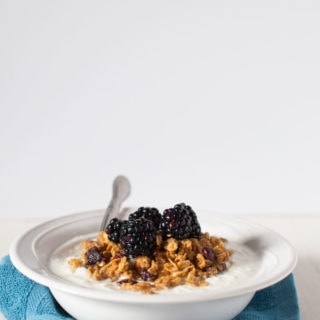
How to Make Yogurt (Without Fancy Equipment)
Ingredients
- half gallon milk more fat in the milk equals thicker yogurt
- ¼ cup store-bought yogurt*
Instructions
- Heat the milk in an uncovered heavy-bottomed pot until the milk reaches 200 degrees (it should be rumbling lightly, but not boiling). Stir and scrape the bottom of the pot occasionally to prevent the milk from burning.
- Take the pot off the heat and allow the milk to cool to about 110 - 115 degrees, or just cool enough for you to comfortably dip your finger in the milk. Stir frequently to prevent skin forming on the milk. While the milk is cooling, put the yogurt in a small bowl and lightly whisk. Once the milk is cooled to 110 - 115 degrees, slowly mix ⅓ of the milk in with the yogurt and whisk until fully combined. Transfer the yogurt mixture back to the pot.
- Place the covered pot in a warm, dry area for 4 hours or up to overnight. You can either leave the pot in an oven with the light turned on or wrap in a towel.
- Either stir in or strain out any whey that forms on top of the set yogurt, depending on how thick you want the yogurt. Reserve the whey for your baking!) Stir the yogurt to ensure it is smooth and creamy and put in jars and refrigerate.
- If you would like flavored or fruity yogurt, mix your additions in the jars and top with the yogurt.

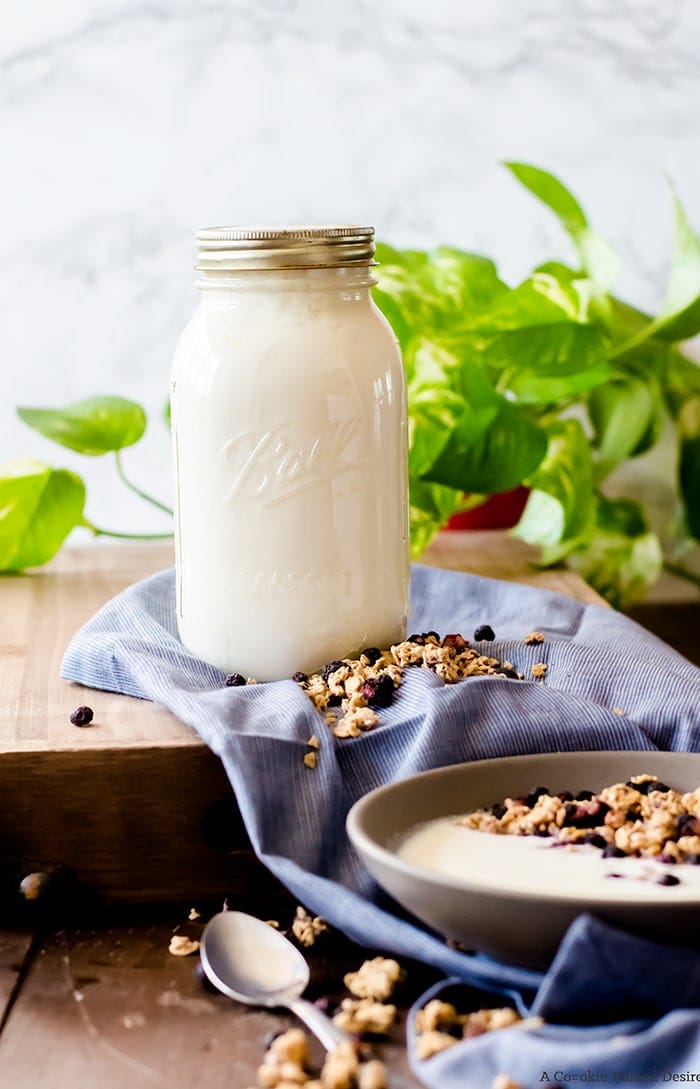
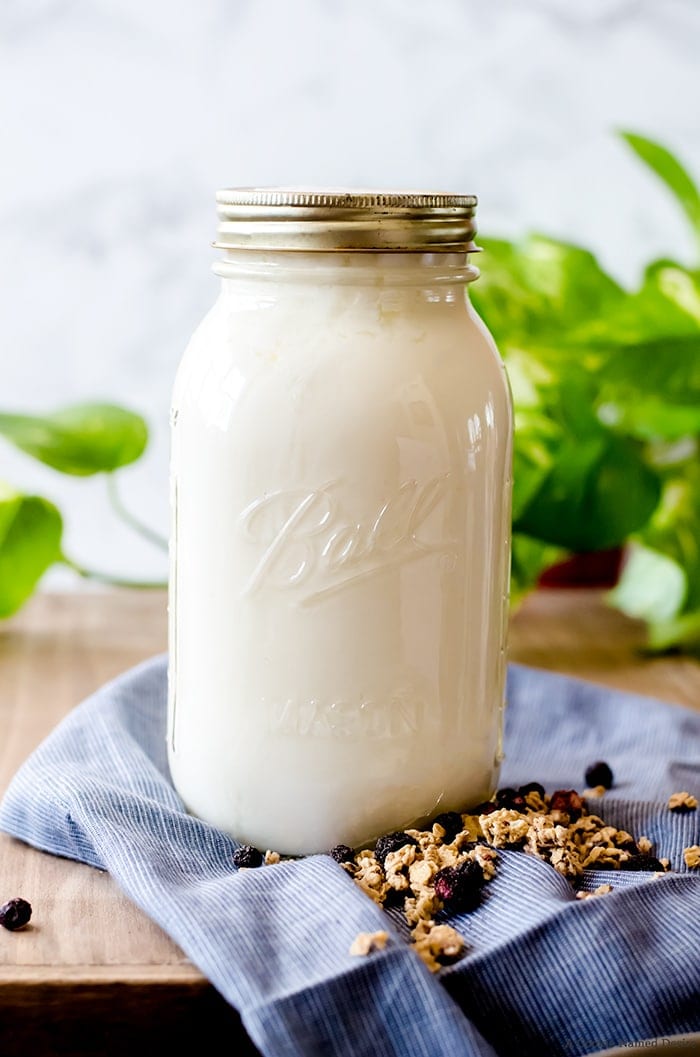
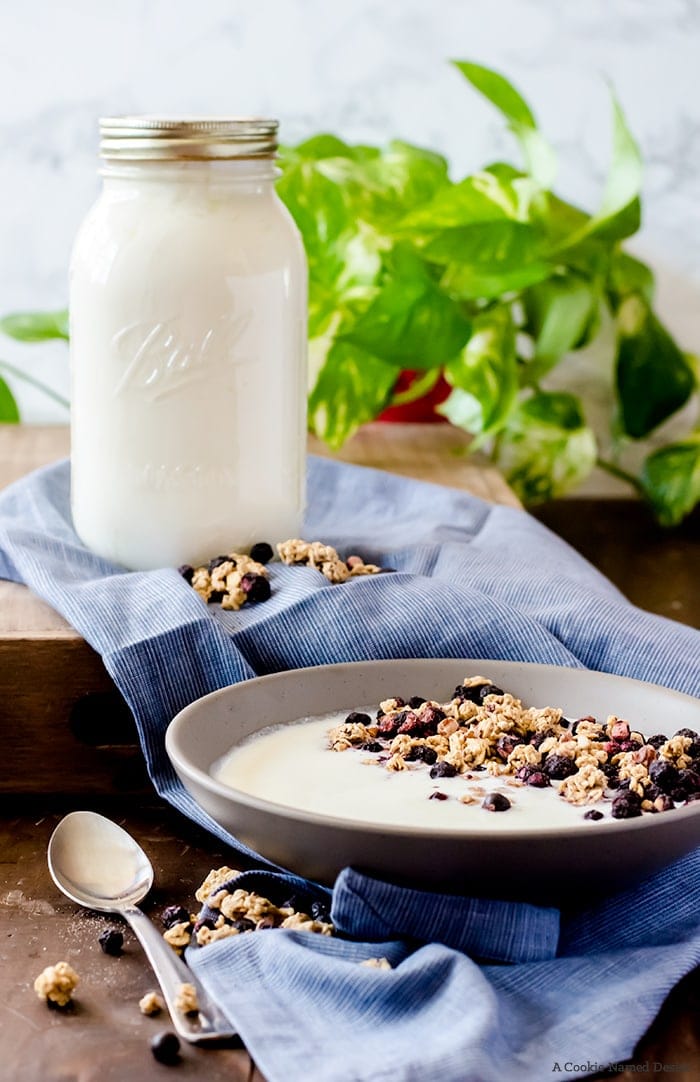
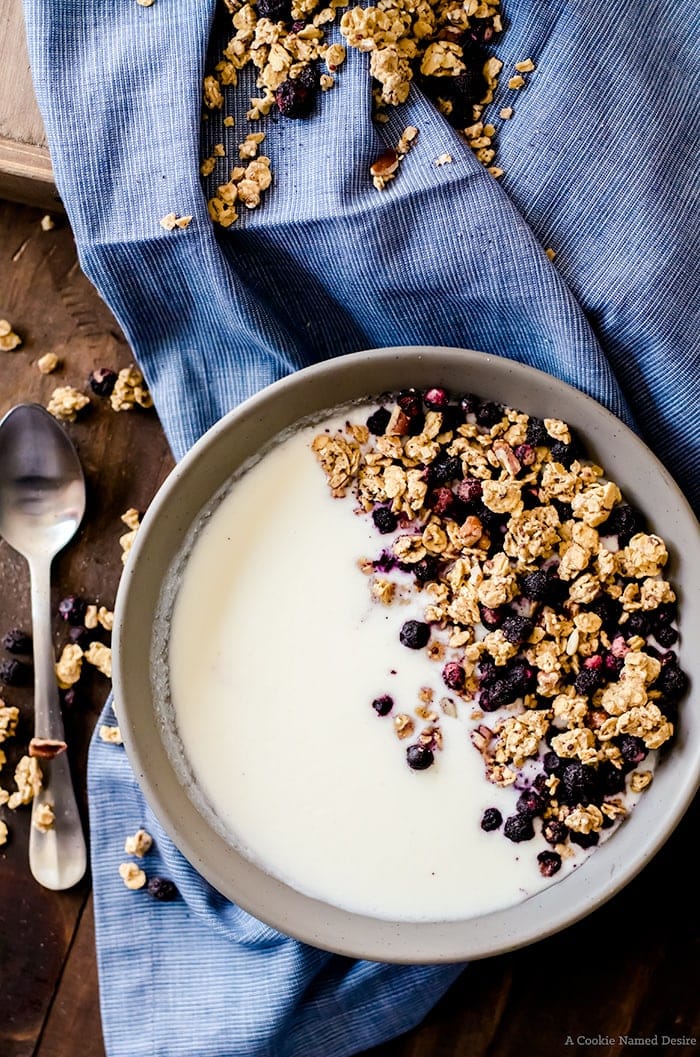

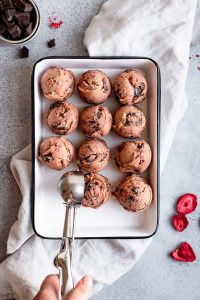
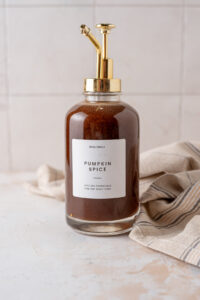
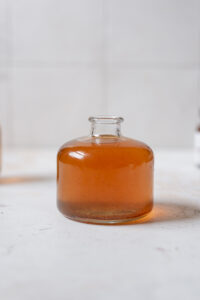
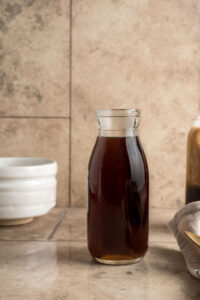
Helen says
I’ve never made yogurt before. Actually I still haven’t. It’s 10:30pm and I can’t wait till morning so that I can go to the store and buy some milk and plain yogurt. I eat yogurt everyday and it gets quite expensive. I can’t wait to start making my own.
Rob Z says
I’ve been making my own yogurt for 16 years. I make it essentially the same way as your recipe, however over the years I’ve tweaked it a bit to make it easier and more foolproof. I heat my milk in a Visions pot in the microwave. Any microwaveable glass pot with lid will work.
I have an old model with low wattage so it takes about 25 minutes to bring 1 quart of cold milk to a gentle boil. The beauty of this is you can’t burn the milk! I can watch it through the window and easily see when it starts to foam up. Once it is about to boil, I remove it and place the pot in a cool bath, until the temperature reaches about 115F. I add about a half cup of the milk to the starter, mix it well, then stir it into the pot. I cover it well with several blankets, towels, whatever is handy and clean.
Eight to 10 hours later, I have a quart of delicious yogurt, and used the same pot to heat the milk and ferment it!
Amanda says
Thank you so much for commenting! I have never tried using the microwave, I will definitely need to try that out instead next time as there are times I can be careless and accidentally burn the milk.
Mary Burnett says
The milk isn't supposed to curle and separate during the heating process is it? It was seperated before it cooled to add the starter yogurt.
Amanda says
Hi Mary, No, it shouldn't curdle. It may have gotten too hot too fast. The best plan of action is to start over and slowly heat up the milk
Susan - ofeverymoment says
This is very similar to the method I use to make my yogurt. I've never used the whey in baking though. I'm curious, when you replace buttermilk with it - do you just use an equal amount of whey, and do you add anything else? I hate wasting it - and this sounds like a great "way" to use up the "whey."
Amanda says
Usually I add some yogurt with it to give it extra creaminess! I also hate wasting things so I do what I can. I also find it is great as a marinade with a touch of yogurt again
Colleen says
I think I would like to try this. I was wondering, what kind of flavours you add? Like, if you just wanted vanilla yogurt, would you add vanilla extract? Or would that seem too artificial tasting? So, is this considered Greek yogurt if I am using a Greek yogurt starter?
Amanda says
Hi Colleen, in order to make it Greek, you would also need to strain the liquid once the yogurt is set. I recommend placing in a cheesecloth for about 1 -2 hours, or until the yogurt is quite thick like Greek yogurt.
Amanda says
To answer your first question, when I have my morning yogurt, I like to add vanilla and stir in things like homemade curd, jams, or granola. As I mentioned in the post, you can o let flavor the yogurt after it is already made. Either before you place it in the refrigerator, or just prior to eating
Thalia @ butter and brioche says
I've only made yoghurt once before - and it turned out great. SO I definitely need to test out this recipe Amanda, yoghurt is something I have every day but never make myself! Xx
Amanda says
It is so simple and the flavor is just incredible. Making it is a wonderful weekend project!
Cakespy says
What a useful and well-written little tutorial! 🙂
Amanda says
Thank you! I make yogurt every few days now and I am obsessed!
laurel says
I always wondered how you made yogurt! Looks so good.